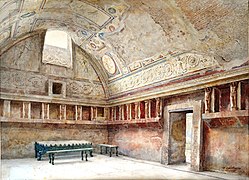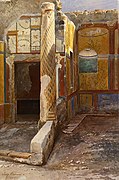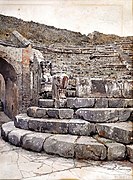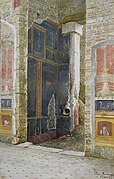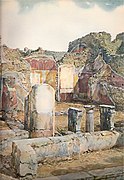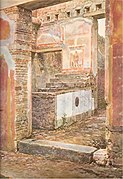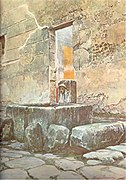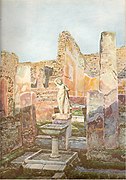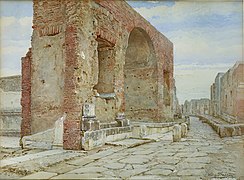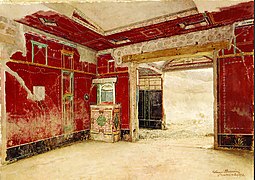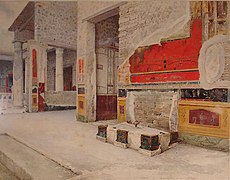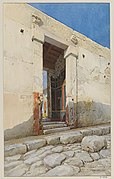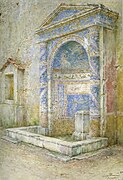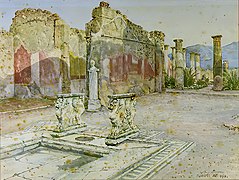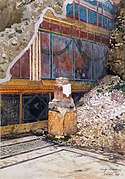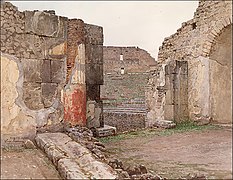Pompeii
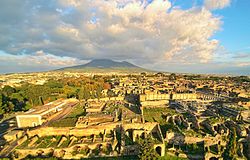 Aerial view of Pompeii | |
| Location | Pompei, Province of Naples, Campania, Italy |
|---|---|
| Coordinates | 40°45′0″N 14°29′10″E / 40.75000°N 14.48611°E |
| Type | Settlement |
| Area | 64 to 67 ha (170 acres) |
| History | |
| Founded | 6th–7th century BC |
| Abandoned | AD 79 |
| Site notes | |
| Website | www |
| Official name | Archaeological Areas of Pompeii, Herculaneum, and Torre Annunziata |
| Type | Cultural |
| Criteria | iii, iv, v |
| Designated | 1997 (21st session) |
| Reference no. | 829 |
| Region | Europe |
Pompeii (/pɒmˈpeɪ(i)/, Latin: [pɔmˈpeːjjiː]) was an ancient Roman city located in the modern comune of Pompei near Naples in the Campania region of Italy. Pompeii, along with Herculaneum and many villas in the surrounding area (e.g. at Boscoreale, Stabiae), was buried under 4 to 6 m (13 to 20 ft) of volcanic ash and pumice in the eruption of Mount Vesuvius in AD 79.
Largely preserved under the ash, the excavated city offers a unique snapshot of Roman life, frozen at the moment it was buried[1] and providing an extraordinarily detailed insight into the everyday life of its inhabitants. It was a wealthy town, enjoying many fine public buildings and luxurious private houses with lavish decorations, furnishings and works of art which were the main attractions for the early excavators. Organic remains, including wooden objects and human bodies, were entombed in the ash and decayed leaving voids which archaeologists found could be used as moulds to make plaster casts of unique and often gruesome figures in their final moments of life. The numerous graffiti carved on the walls and inside rooms provide a wealth of examples of the largely lost Vulgar Latin spoken colloquially at the time, contrasting with the formal language of the classical writers.
Pompeii is a UNESCO World Heritage Site status and is one of the most popular tourist attractions in Italy, with approximately 2.5 million visitors annually.[2]
After many excavations prior to 1960 that had uncovered most of the city but left it in decay,[3] further major excavations were banned and instead they were limited to targeted, prioritised areas. In 2018, these led to new discoveries in some previously unexplored areas of the city.[4][5][6][7]
Name
Pompeii (pronounced [pɔmˈpɛjjiː]) in Latin is a second declension plural noun (Pompeiī, -ōrum). According to Theodor Kraus, "The root of the word Pompeii would appear to be the Oscan word for the number five, pompe, which suggests that either the community consisted of five hamlets or perhaps it was settled by a family group (gens Pompeia)."[8]

Geography

Pompeii was built about 40 m above sea level on a lava plateau on the coast created by earlier eruptions of Mount Vesuvius, (8 km (5.0 mi) distant). The plateau fell steeply to the south and partly the west. Three sheets of sediment from large landslides lie on top of the lava, perhaps triggered by extended rainfall.[9] The city bordered the coastline, though today it is 700 metres away. The mouth of the navigable Sarno River, adjacent to the city, was protected by lagoons and served early Greek and Phoenician sailors as a safe haven and port which was developed further by the Romans.
Pompeii covered a total of 64 to 67 hectares (170 acres) and was home to 11,000 to 11,500 people, based on household counts.[10]
History
Early history

red: 1st (Samnite) town
blue: 1st expansion
green: 2nd expansion
yellow: Roman expansion
The first stable settlements on the site date back to the 8th century BC when the Oscans,[11] a people of central Italy, founded five villages in the area.
With the arrival of the Greeks in Campania from around 740 BC, Pompeii entered the orbit of the Hellenic people and the most important building of this period is the Doric Temple, built away from the centre in what would later become the Triangular Forum.[12]: 62 At the same time the cult of Apollo was introduced.[13] Greek and Phoenician sailors used the location as a safe port.
Around the 6th century BC, the settlement merged into a single community centred on the important crossroad between Cumae, Nola, and Stabiae and was surrounded by a tufa city wall (the pappamonte wall).[14] The first wall followed the same course as the later wall and, unusually, enclosed a much greater area than the early town to include agricultural land.[15] It began to flourish and maritime trade started with the construction of a small port near the mouth of the river.[12] The earliest settlement was focused in regions VII and VIII of the town (the altstadt) as identified from stratigraphy below the Samnite and Roman buildings.
In 524 BC the Etruscans arrived and settled in the area, including Pompeii, finding in the River Sarno a communication route between the sea and the interior. Like the Greeks, the Etruscans did not conquer the city militarily, but simply controlled it and Pompeii enjoyed a sort of autonomy.[12]: 63 Nevertheless, Pompeii became a member of the Etruscan League of cities.[16] Excavations in 1980–1981 have shown the presence of Etruscan inscriptions and a 6th-century BC necropolis.[17] Under the Etruscans a primitive forum or simple market square was built, as well as the temple of Apollo, in both of which objects including fragments of bucchero were found by Maiuri.[18] Several houses were built with the so-called Tuscan atrium, typical of this people.[12]: 64
The city wall was strengthened in the early-5th century BC with two façades of relatively thin, vertically set, slabs of Sarno limestone some four metres apart filled with earth (the orthostate wall).[19]
In 474 BC the Greek city of Cumae, allied with Syracuse, defeated the Etruscans at the Battle of Cumae and gained control of the area.
The Samnite period

The period between about 450–375 BC witnessed large areas of the city being abandoned while important sanctuaries such as the Temple of Apollo show a sudden lack of votive material remains.[20]
The Samnites, people from the areas of Abruzzo and Molise, and allies of the Romans, conquered Greek Cumae between 423 and 420 BC and it is likely that all the surrounding territory, including Pompeii, was conquered around 424 BC. The new rulers gradually imposed their architecture and enlarged the town.
From 343 BC the first Roman army entered the Campanian plain bringing with it the customs and traditions of Rome and in the Roman war against the Latins the Samnites were faithful to Rome. Pompeii, although governed by the Samnites, entered the Roman orbit, to which it remained faithful even during the third Samnite war and in the war against Pyrrhus.
The city walls were reinforced in Sarno stone in the early 3rd century BC (the limestone enceinte, or the "first Samnite wall"). It formed the basis for the currently visible walls with an outer wall of rectangular limestone blocks as a terrace wall supporting a large agger, or earth embankment, behind it.
After the Samnite Wars from 290 BC, Pompeii was forced to accept the status of socii of Rome, maintaining, however, linguistic and administrative autonomy.
From the outbreak of the Second Punic War (218–201 BC) in which Pompeii remained faithful to Rome, an additional internal retaining wall was built and the agger and outer façade raised resulting in a double parapet with wider wall-walk.[12] Despite the political uncertainty of these events and the progressive migration of wealthy men to quieter cities in the eastern Mediterranean, Pompeii continued to flourish due to the production and trade of wine and oil with places like Provence and Spain,[21] as well as to intensive agriculture on farms around the city.
In the 2nd century BC, Pompeii enriched itself by taking part in Rome's conquest of the east as shown by a statue of Apollo in the Forum erected by Lucius Mummius in gratitude for their support in the sack of Corinth and the eastern campaigns. These riches enabled Pompeii to bloom and expand to its ultimate limits. The forum and many public and private buildings of high architectural quality were built, including the large theatre, the sanctuary to Jupiter, the Basilica, the Comitium, the Stabian Baths and a new two-story portico.[22]
The Roman period
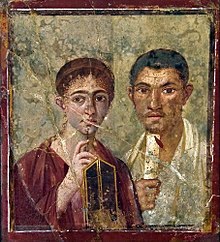
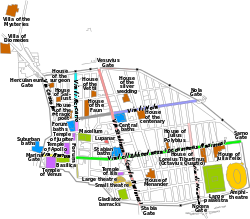
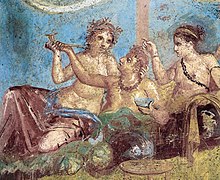
Pompeii took part in the Social Wars that the towns of Campania initiated against Rome, but in 89 BC it was besieged by Sulla. Although the battle-hardened troops of the Social League, headed by Lucius Cluentius, helped in resisting the Romans, in 89 BC Pompeii was forced to surrender after the conquest of Nola, culminating in many of Sulla's veterans being given land and property, while many of those who went against Rome were ousted from their homes. Despite all that, the Pompeians were granted Roman citizenship, for which they fought, and they were quickly assimilated into the Roman world. Pompeii became a Roman colony with the name of Colonia Cornelia Veneria Pompeianorum. The city became an important passage for goods that arrived by sea and had to be sent toward Rome or southern Italy along the nearby Appian Way. The main language in the city became Latin,[24] and many of Pompeii's old aristocratic families Latinized their names as a sign of assimilation.[25]
From c. 20 BC, Pompeii was fed with water by a spur from the Serino aqueduct or Aqua Augusta (Naples) built by Agrippa; the main line supplied several other large towns and the important naval base at Misenum. The castellum aquae is well preserved, and includes many details of the distribution network and its controls.[26]
In 59, there was a serious riot and bloodshed in the amphitheatre between Pompeians and Nucerians (which is recorded in a fresco) and which led the Roman senate to ban further events for a period of ten years.[27][28]
AD 62–79
The inhabitants of Pompeii had long been used to minor earthquakes (indeed, the writer Pliny the Younger wrote that earth tremors "were not particularly alarming because they are frequent in Campania"), but on 5 February 62[29] a severe earthquake did considerable damage around the bay, and particularly to Pompeii. It is believed that the earthquake would have registered between about 5 and 6 on the Richter magnitude scale.[30]
On that day in Pompeii, there were to be two sacrifices, as it was the anniversary of Augustus being named "Father of the Nation" and also a feast day to honour the guardian spirits of the city. Chaos followed the earthquake; fires caused by oil lamps that had fallen during the quake added to the panic. Nearby cities of Herculaneum and Nuceria were also affected.[30]
Between 62 and the eruption in 79 most rebuilding was done at least in the private sector.[31] It was thought until recently that some of the damage had still not been repaired at the time of the eruption but this has been shown to be doubtful as the evidence of missing forum statues and marble wall-veneers are most likely due to robbers after the city's burial.[32][33] The respective public buildings on the east side of the forum were in fact largely restored and were even enhanced by beautiful marble veneers and other modifications to the architecture.[34]
An important field of current research concerns structures that were restored between the earthquake of 62 and the eruption. Older, damaged frescoes were often covered with newer ones, for example. Nevertheless, some buildings like the Central Baths were only started after the earthquake and were built to enhance the city with modern developments in their architecture as had been done in Rome in terms of wall-heating and window glass, and with well-lit spacious rooms. The new baths took over a whole insula by demolishing houses, which may have been made easier by the earthquake that had damaged these houses. This shows that the city was still flourishing rather than struggling to recover from the earthquake.[35]
In about 64 Nero and his wife Poppaea visited Pompeii and made gifts to the temple of Venus, probably when he performed in the theatre of Naples.[36]
Eruption of Vesuvius
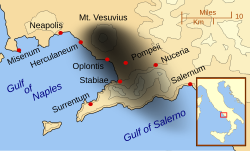


By the 1st century AD, Pompeii was one of a number of towns near the base of the volcano, Mount Vesuvius. The area had a substantial population of roughly between 12,000 and 15,000[37][38], which had grown prosperous from the region's renowned agricultural fertility. Many of Pompeii's neighbouring communities, most famously Herculaneum, also suffered damage or destruction during the 79 eruption.[39]
A multidisciplinary volcanological and bio-anthropological study of the eruption products and victims, merged with numerical simulations and experiments, indicates that at Pompeii and surrounding towns heat was the main cause of death of people, previously believed to have died by ash suffocation. The results of the study, published in 2010, show that exposure to at least 250 °C (482 °F) hot surges (known as pyroclastic flows) at a distance of 10 kilometres (6 miles) from the vent was sufficient to cause instant death, even if people were sheltered within buildings.[40] The people and buildings of Pompeii were covered in up to 12 different layers of tephra, in total 25 metres (82.0 ft) deep, which rained down for about six hours.
Pliny the Younger provided a first-hand account of the eruption of Mount Vesuvius from his position across the Bay of Naples at Misenum but written 25 years after the event. His uncle, Pliny the Elder, with whom he had a close relationship, died while attempting to rescue stranded victims. As admiral of the fleet, Pliny the Elder had ordered the ships of the Imperial Navy stationed at Misenum to cross the bay to assist evacuation attempts. Volcanologists have recognised the importance of Pliny the Younger's account of the eruption by calling similar events "Plinian". It had long been thought that the eruption was an August event based on one version of the letter but another version[41] gives a date of the eruption as late as 23 November. A later date is consistent with a charcoal inscription at the site, discovered in 2018, which includes the date of 17 October and which must have been recently written.[42][43]
Further support for an October/November eruption is found in the fact that people buried in the ash appear to have been wearing heavier clothing than the light summer clothes typical of August. The fresh fruit and vegetables in the shops are typical of October – and conversely the summer fruit typical of August was already being sold in dried, or conserved form. Wine fermenting jars had been sealed, which would have happened around the end of October. Coins found in the purse of a woman buried in the ash include one with a 15th imperatorial acclamation among the emperor's titles. These coins could not have been minted before the second week of September.[41]
Rediscovery and excavations

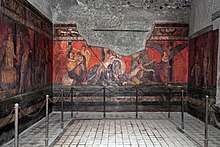

Soon after the burial of the city, some survivors or thieves came to salvage valuables, including marble statues from the forum and other precious materials from buildings. The city was not completely buried and tops of larger buildings would have been above the ash making it obvious where to dig or salvage building material.[44] The robbers left traces of their passage, as in a house where modern archaeologists found wall graffito saying "house dug".[45] Nevertheless, over the following centuries, its name and location were forgotten.
The next known date that any part was unearthed was in 1592, when the digging of an underground channel to divert the River Sarno ran into ancient walls covered with paintings and inscriptions. The architect Domenico Fontana was called in; he unearthed a few more frescoes, then covered them over again, and nothing more came of the discovery. A wall inscription had mentioned a decurio Pompeii ('the town councillor of Pompeii') but its reference to the long-forgotten Roman city was missed.
Herculaneum itself was rediscovered in 1738 by workmen digging for the foundations of a summer palace for the King of Naples, Charles of Bourbon and due to the spectacular quality of the finds the Spanish military engineer Rocque Joaquin de Alcubierre made excavations to find further remains at the site of Pompeii in 1748 even if the city was not identified.[46] Charles of Bourbon took great interest in the finds, even after leaving to become king of Spain, because the display of antiquities reinforced the political and cultural prestige of Naples.[47] On August 20, 1763, an inscription [...] Rei Publicae Pompeianorum [...] was found and the city was identified as Pompeii.[48]
Karl Weber directed the first scientific excavations.[49] He was followed in 1764 by military engineer Franscisco la Vega who was succeeded by his brother, Pietro, in 1804.[50]
There was much progress in exploration when the French occupied Naples in 1799 and ruled over Italy from 1806 to 1815. The land on which Pompeii lies was expropriated and up to 700 workers were used in the excavations. The excavated areas in the north and south were connected. Parts of the Via dell'Abbondanza were also exposed in west-east direction and for the first time an impression of the size and appearance of the ancient town could be appreciated. In the following years, the excavators struggled with lack of money and excavations progressed slowly, but with significant finds such as the houses of the Faun, the Meleager, the tragic poet and the Dioscuri.
Giuseppe Fiorelli took charge of the excavations in 1863 and made greater progress.[51] During early excavations of the site, occasional voids in the ash layer had been found that contained human remains. It was Fiorelli who realised these were spaces left by the decomposed bodies and so devised the technique of injecting plaster into them to recreate the forms of Vesuvius's victims. This technique is still in use today, with a clear resin now used instead of plaster because it is more durable, and does not destroy the bones, allowing further analysis.[52]
Fiorelli also introduced scientific documentation. He divided the city into the present nine areas (regiones) and blocks (insulae) and numbered the entrances of the individual houses (domus), so that each is identified by these three numbers. Fiorelli also published the first periodical with excavation reports. Under Fiorelli's successors the entire west of the city was exposed.
Modern archaeology
In the 1920s Amedeo Maiuri excavated for the first time in older layers than that of 79 AD in order to learn about the settlement history. Maiuri made the last excavations on a grand scale in the 1950s, and the area south of the Via dell'Abbondanza and the city wall was almost completely uncovered, but they were poorly documented scientifically. Preservation was haphazard and presents today's archaeologists with great difficulty. Questionable reconstruction was done in the 1980s and 1990s after the severe earthquake of 1980, which caused great destruction. Since then, except for targeted soundings and excavations, work was confined to the excavated areas. Further excavations on a large scale are not planned and today archaeologists try to reconstruct, to document and, above all, to stop the ever faster decay.
Under the Great Pompeii Project over 2.5 km of ancient walls are being relieved of danger of collapse by treating the unexcavated areas behind the street fronts in order to increase drainage and reduce the pressure of ground water and earth on the walls, a problem especially in the rainy season. As of August 2019, these excavations have resumed on unexcavated areas of Regio V.[53]
Conservation
Objects buried beneath Pompeii were well-preserved for almost 2,000 years as the lack of air and moisture allowed little to no deterioration. However, once exposed, Pompeii has been subject to both natural and man-made forces, which have rapidly increased deterioration.
Weathering, erosion, light exposure, water damage, poor methods of excavation and reconstruction, introduced plants and animals, tourism, vandalism and theft have all damaged the site in some way. Two-thirds of the city has been excavated, but the remnants of the city are rapidly deteriorating.[54]
Furthermore, during World War II many buildings were badly damaged or destroyed by bombs dropped in several raids by the Allied forces.[55]
The concern for conservation has continually troubled archaeologists. The ancient city was included in the 1996 World Monuments Watch by the World Monuments Fund, and again in 1998 and in 2000. In 1996 the organisation claimed that Pompeii "desperately need[ed] repair" and called for the drafting of a general plan of restoration and interpretation.[56] The organisation supported conservation at Pompeii with funding from American Express and the Samuel H. Kress Foundation.[57]
Today, funding is mostly directed into conservation of the site; however, due to the expanse of Pompeii and the scale of the problems, this is inadequate in halting the slow decay of the materials. A 2012 study recommended an improved strategy for interpretation and presentation of the site as a cost-effective method of improving its conservation and preservation in the short term.[58]
In June 2013, UNESCO declared: If restoration and preservation works “fail to deliver substantial progress in the next two years,” Pompeii could be placed on the List of World Heritage in Danger.[59]
House of the Gladiators collapse
The 2,000-year-old Schola Armatorum ('House of the Gladiators') collapsed on 6 November 2010. The structure was not open to visitors, but the outside was visible to tourists. There was no immediate determination as to what caused the building to collapse, although reports suggested water infiltration following heavy rains might have been responsible. There has been fierce controversy after the collapse, with accusations of neglect.[60][61]
Roman city development
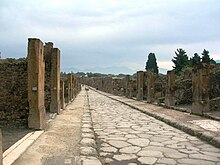




Under the Romans, Pompeii underwent a process of urban development especially in the Augustan period. Public buildings include the forum, the amphitheatre with palaestra or gymnasium with a central natatorium (cella natatoria) or swimming pool, two theatres, and at least four public baths. The amphitheatre has been cited by scholars as a model of sophisticated design, particularly in the area of crowd control.[62]
Other service buildings were found: the Macellum ('great food market'); the Pistrinum ('mill'); the Thermopolium (a fast food place that served hot and cold dishes and beverages), and cauponae ('cafes' or 'dives' with a seedy reputation as hangouts for thieves and prostitutes). At least one building, the Lupanar, was dedicated to prostitution.[63] A large hotel or hospitium (of 1,000 square metres) was found at Murecine a short distance from Pompeii when the Naples-Salerno motorway was being built, and the Murecine Silver Treasure and the Tablets providing a unique record of business transactions were discovered.[64][65]
An aqueduct provided water to the public baths, to more than 25 street fountains, and to many private houses (domūs) and businesses. The aqueduct was a fed from a branch of the great Serino Aqueduct built to serve the Bay of Naples region.
Modern archaeologists have excavated garden sites and urban domains to reveal the agricultural staples of Pompeii's economy. Pompeii was fortunate to have had fertile soil for crop cultivation. The soils surrounding Mount Vesuvius preceding its eruption have been revealed to have had good water-retention capabilities, implying productive agriculture. The Tyrrhenian Sea's airflow provided hydration to the soil despite the hot, dry climate.[66] Barley, wheat, and millet were all produced along with wine and olive oil, in abundance for export to other regions.[67]
Evidence of wine imported nationally from Pompeii in its most prosperous years can be found from recovered artefacts such as wine bottles in Rome.[67] For this reason, vineyards were of utmost importance to Pompeii's economy. Agricultural policymaker Columella suggested that each vineyard in Rome produced a quota of three cullei of wine per jugerum, otherwise the vineyard would be uprooted. The nutrient-rich lands near Pompeii were extremely efficient at this and were often able to exceed these requirements by a steep margin, therefore providing the incentive for local wineries to establish themselves.[67] While wine was exported for Pompeii's economy, the majority of the other agricultural goods were likely produced in quantities sufficient for the city's consumption.
Remains of large formations of constructed wineries were found in the Forum Boarium, covered by cemented casts from the eruption of Vesuvius.[67] It is speculated that these historical vineyards are strikingly similar in structure to the modern day vineyards across Italy.
Carbonised food plant remains, roots, seeds and pollens, have been found from gardens in Pompeii, Herculaneum and from the Roman villa at Torre Annunziata. They revealed that emmer wheat, Italian millet, common millet, walnuts, pine nuts, chestnuts, hazel nuts, chickpeas, bitter vetch, broad beans, olives, figs, pears, onions, garlic, peaches, carob, grapes, and dates were consumed. All but the dates could have been produced locally.[68]
Erotic art
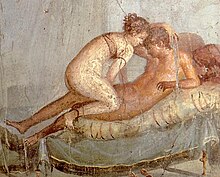
The discovery of erotic art in Pompeii and Herculaneum left the archaeologists with a dilemma stemming from the clash of cultures between the mores of sexuality in ancient Rome and in Counter-Reformation Europe. An unknown number of discoveries were hidden away again. A wall fresco depicting Priapus, the ancient god of sex and fertility, with his grotesquely enlarged penis, was covered with plaster. An older reproduction was locked away "out of prudishness" and opened only on request – and only rediscovered in 1998 due to rainfall.[69] In 2018, an ancient fresco depicting an erotic scene of "Leda and the Swan" was discovered at Pompeii.[70]
Many artefacts from the buried cities are preserved in the Naples National Archaeological Museum. In 1819, when King Francis visited the Pompeii exhibition there with his wife and daughter, he was so embarrassed by the erotic artwork that he had it locked away in a "secret cabinet" (gabinetto segreto), a gallery within the museum accessible only to "people of mature age and respected morals". Re-opened, closed, re-opened again and then closed again for nearly 100 years, the Naple's "Secret Museum" was briefly made accessible again at the end of the 1960s (the time of the sexual revolution) and was finally re-opened for viewing in 2000. Minors are still allowed entry only in the presence of a guardian or with written permission.[71]
Gallery of Luigi Bazzani's Watercolors of Pompeii when first excavated
(See more on Wikimedia Commons)
-
Summer Triclinium of House V, 2, 15, 1914
-
Pompeii Bath
-
Lararium of the House of Dioscuri, 1902
-
House of the Great Fountain
-
Atrium of the House of the Centenary, 1901
-
Peristyle with fountain in the House of Marcus Lucretius
-
Peristyle with fountain in the House of Marcus Lucretius (Detail)
-
Pompeii Interior
-
Pompeii theater
-
Lararium of the House IX,1,7, Pompeii,1903
-
Nymphaeum at the House of the Bull, 1901
-
Atrium of the House of the Mariner
-
House of the Vetti
-
House of the Small Fountain
-
House with impluvium and marble table
-
Insula in Region IX, V, 18
-
Temple of Isis
-
Thermopolion (fast food stall) in the alley of the rooster
-
Fountain with head of Mercury on Mercury Street
-
House of the Hanging Balcony
-
Portal of a patrician house on Augustus Street
-
Tomb in the necropolis
-
Tomb with covered niche and planter with garland
-
Lararium in the House of L Caecilius Jucundus
-
Pompeii Atrium
-
Arches of Nero in the Forum
-
Pompeian red interior
-
The Genaeceum (Women's Quarters) of the House of Sallust (VI 2, 4)
-
Thermopolium in the Alley of the Pharmacist
-
Atrium of the House of the Ancient Hunt
-
Atrium of the House of the Ancient Hunt (Detail)
-
Atrium in Pompeii
-
Atrium of the House of the Vetti VI.15.1
-
Entry to a Roman domus
-
Atrium of the House of the Prince of Naples
-
Fountain of the House of C. Virnius Modestus (IX 7, 16)
-
Atrium of the House of Cornelius Rufus
-
Colonnade of the House of Cornelius Rufus
-
House of the Silver Wedding
-
Lararium of a family altar, seen in situ after excavation, House of Aulus Vettius, Pompeii, c. 36–39 AD, 1895
-
Lararium of the House of Paccius Alexander (IX 1, 7)
-
Large theater in Pompeii, 1910,
-
Pompeii forum
-
The Temple of Fortuna Augusta
Tourism
Pompeii has been a popular tourist destination for over 250 years;[72] it was on the Grand Tour. By 2008, it was attracting almost 2.6 million visitors per year, making it one of the most popular tourist sites in Italy.[73] It is part of a larger Vesuvius National Park and was declared a World Heritage Site by UNESCO in 1997. To combat problems associated with tourism, the governing body for Pompeii, the Soprintendenza Archaeological di Pompei, have begun issuing new tickets that allow tourists to visit cities such as Herculaneum and Stabiae as well as the Villa Poppaea, to encourage visitors to see these sites and reduce pressure on Pompeii.
Pompeii is a driving force behind the economy of the nearby town of Pompei. Many residents are employed in the tourism and hospitality industry, serving as taxi or bus drivers, waiters, or hotel staff.[citation needed]
Excavations at the site have generally ceased due to a moratorium imposed by the superintendent of the site, Professor Pietro Giovanni Guzzo. The site is generally less accessible to tourists than in the past, with less than a third of all buildings open in the 1960s being available for public viewing today.
In popular culture
Pompeii was the setting for the British comedy television series Up Pompeii! and the movie of the series. Pompeii also featured in the second episode of the fourth season of revived BBC science fiction series Doctor Who, named "The Fires of Pompeii",[74] which featured Caecilius as a character.
In 1971, the rock band Pink Floyd filmed a live concert titled Pink Floyd: Live at Pompeii, in which they performed six songs in the ancient Roman amphitheatre in the city. The audience consisted only of the film's production crew and some local children.
Siouxsie and the Banshees wrote and recorded the punk-inflected dance song "Cities in Dust", which describes the disaster that befell Pompeii and Herculaneum in AD 79. The song appears on their album Tinderbox, released in 1985, on Polydor Records. The jacket of the single remix of the song features the plaster cast of the chained dog killed in Pompeii.
Pompeii is a novel written by Robert Harris (published in 2003) featuring the account of the aquarius's race to fix the broken aqueduct in the days leading up to the eruption of Vesuvius, inspired by actual events and people.
"Pompeii" is a song by the British band Bastille, released 24 February 2013. The lyrics refer to the city and the eruption of Mount Vesuvius.
Pompeii is a 2014 German-Canadian historical disaster film produced and directed by Paul W. S. Anderson.[75]
In 2016, 45 years after the Pink Floyd recordings, band guitarist David Gilmour returned to the Pompeii amphitheatre to perform a live concert for his Rattle That Lock Tour. This event was considered the first in the amphitheatre to feature an audience since the AD 79 eruption of Vesuvius.[76][77]
Documentaries
- In Search of...'s episode No. 82 focuses entirely on Pompeii; it premiered on November 29, 1979.
- The National Geographic special In the Shadow of Vesuvius (1987) explores the sites of Pompeii and Herculaneum, interviews (then) leading archaeologists, and examines the events leading up to the eruption of Vesuvius.[78]
- Ancient Mysteries: Pompeii: Buried Alive (1996), an A&E television documentary narrated by Leonard Nimoy.[79]
- Pompeii: The Last Day (2003), an hour-long drama produced for the BBC that portrays several characters (with historically attested names, but fictional life-stories) living in Pompeii, Herculaneum and around the Bay of Naples, and their last hours, including a fuller and his wife, two gladiators, and Pliny the Elder. It also portrays the facts of the eruption.
- Pompeii and the AD 79 eruption (2004), a two-hour Tokyo Broadcasting System documentary.
- Pompeii Live (June 28, 2006), a Channel 5 production featuring a live archaeological dig at Pompeii and Herculaneum[80][81]
- Pompeii: The Mystery of the People Frozen in Time (2013), a BBC One drama documentary presented by Dr. Margaret Mountford.[82]
- The Riddle of Pompeii (May 23, 2014), Discovery Channel.[83]
- Pompeii's People (September 3, 2017), a CBC Gem documentary presented by David Suzuki.[84]
See also
- Eumachia
- House of Julia Felix
- House of Loreius Tiburtinus
- House of Menander
- House of Sallust
- House of the Tragic Poet
- House of the Vettii
- Macellum of Pompeii
- Mastroberardino, a project with the Italian winery Mastroberardino to replant the vineyards of Pompeii
- Robert Rive, 1850s photographer of Pompeii
- Suburban Baths (Pompeii)
- Temple of Isis (Pompeii)
- Volcanic destruction
- Armero tragedy, a city in Colombia that suffered a similar fate in 1985
- Joya de Cerén, a pre-Columbian farming village in El Salvador known as the "Pompeii of the Americas"
- Plymouth, Montserrat, former capital city buried by volcanic ash from the Soufrière Hills volcano in the 1990s
- Saint-Pierre, Martinique, town similarly destroyed by the volcanic eruption of Mount Pelee, in 1902
- Other
- Dura-Europos, also known as the "Pompeii of the desert"
- Aeclanum
- Cumae
- Oplonti
- Stabiae
References
- ^ De Carolis & Patricelli 2003, p. 83
- ^ "Dossier Musei 2008" (PDF). Touring Club Italiano (in Italian). Archived from the original (PDF) on March 18, 2009. Retrieved September 30, 2012.
- ^ Giovanni Longobardi, Sustainable Pompeii, Rome, L'Erma di Bretschneider, 2002. ISBN 88-8265-189-4
- ^ "Homepage – Pompeii Sites Portale Ufficiale Parco Archeologico di Pompei". Pompeii Sites.
- ^ "Pompeii victim crushed by boulder while fleeing eruption". BBC. May 30, 2018. Retrieved June 13, 2018.
- ^ Squires, Nick (April 25, 2018). "Skeleton of child trying to shelter from Vesuvius eruption uncovered in Pompeii". The Telegraph. Retrieved June 13, 2018.
- ^ Squires, Nick (May 11, 2018). "Remains of ancient Roman horse found at Pompeii in dig started by tomb raiders". The Telegraph. Retrieved June 13, 2018.
- ^ Kraus 1975, p. [page needed]
- ^ Senatore, Stanley & Pescatore 2004, p. [page needed]
- ^ Wilson, Andrew (2011). "City Sizes and Urbanization in the Roman Empire". In Bowman, Alan; Wilson, Andrew (eds.). Settlement, Urbanization, and Population. Oxford Studies on the Roman Economy. Vol. 2. Oxford, England: Oxford University Press. pp. 171–172. ISBN 978-0-19-960235-3.
- ^ Arnold De Vos; Mariette De Vos (1982). Pompeii, Herculaneum, Stabia, Rome: Giuseppe Laterza & figli Publishing House. ISBN 88-420-2001-X
- ^ a b c d e Etienne, Robert (1992). Daily Life in Pompeii. Milan: Arnoldo Mondadori Editore. ISBN 88-04-35466-6.
- ^ Paul Zanker (1993). Pompeii: society, urban images and forms of living, Turin: Giulio Einaudi Editore. ISBN 88-06-13282-2 p. 60
- ^ Touring Club Italiano, Guida d'Italia – Naples and surroundings, Milan, Touring Club Editore, 2008. ISBN 978-88-365-3893-5
- ^ P. G. Guzzo, “Alla ricerca della Pompei sannitica,” in Studi sull’Italia dei Sanniti, Milan, 2000, pp. 107–117. See also the discussion in Guzzo (ed.), Pompei. Scienza e Società, p. 159 (F. Coarelli) and p. 161 (H. Geertman)
- ^ W. Keller: The Etruscans ISBN 978-0224010719
- ^ Arthur, P. (1986) "Problems of the urbanization of Pompeii: excavations 1980–1981". Antiquaries Journal 66: 29–44.
- ^ Arnold De Vos ; Mariette De Vos, Pompeii, Herculaneum, Stabia, Rome, Giuseppe Laterza & Figli Publishing House, 1982. ISBN 88-420-2001-X p. 8
- ^ Chiaramonte Treré: "The Walls and Gates", in Dobbins & Foss, eds., The World of Pompeii (Routledge 2007) ISBN 0-203-86619-3
- ^ The City Walls of Pompeii: Perceptions and Expressions of a Monumental Boundary by Ivo van der Graaff, M.A. Dissertation. Graduate School of The University of Texas, p. 56
- ^ Paul Zanker, Pompeii: society, urban images and forms of living, Turin, Giulio Einaudi Editore, 1993. ISBN 88-06-13282-2 p. 60
- ^ ecolo a.C." In Sicilia ellenistica, consuetudo italica. Alle origini dell’architettura ellenistica d’occidente. Spoleto, complesso monumentale di S. Nicolò, 5–7 Novembre 2004, edited by M. Osanna and M. Torelli (Pisa, 2006), 227–241.
- ^ Clarke 2006, pp. 262–264.
- ^ Beard, Mary (2008). Pompeii. Profile Books LTD. ISBN 978-1-86197-596-6.
- ^ Butterworth, Alex (2005). Pompeii – The Living City. St Martin's Press; 1st edition. ISBN 978-0-312-35585-2.
- ^ Lorenz, Wayne (June 2011). "Pompeii (and Rome) Water Supply Systems" (PDF). Wright Paleohydrological Institute. p. 26. Retrieved 23 June 2017.
- ^ Tacitus: Ann. 14.17
- ^ See W. O. Moeller, “The Riot of AD 59 at Pompeii,” Historia, 1970, vol. 19, pp. 84–95
- ^ "Patterns of Reconstruction at Pompeii". University of Virginia. Retrieved September 30, 2012.
- ^ a b "Visiting Pompeii". Current Archaeology. p. 3. Archived from the original on August 20, 2008. Retrieved September 30, 2012.
- ^ The World of Pompeii, Edited by John J. Dobbins and Pedar W. Foss, ISBN 0-203-86619-3, p. 173
- ^ Dobbins, J. J., “Problems of chronology, decoration, and urban design in the forum at Pompeii”, AJA, 1994, vol. 98, pp. 629–694
- ^ Wallat, K., Die Ostseite des Forums von Pompeji, Frankfurt am Main, 1997.
- ^ “Der Zustand des Forums von Pompeji am Vorabend des Vesuvausbruchs 79 n.Chr”, in T. Fröhlich and L. Jacobelli (eds), Archäologie und Seismologie. La regione vesuviana dal 62 at 79 d.C. Problemi archeologici e sismologici (Colloquium Boscoreale, 26–27 November 1993), Munich, 1995, pp. 75–92.
- ^ John J. Dobbins, Pedar W. Foss, The World of Pompeii, ISBN 0-415-17324-8 (hbk), p. 126
- ^ M. Mastroroberto, “Una visita di Nerone a Pompei: le deversoriae tabernae di Moregine,” in A. D’Ambrosio, P. G. Guzzo and M. Mastroroberto (eds), Storie da un’eruzione. Exhib. Catalogue Naples–Bruxelles 2003–2004, 2003, pp. 479–523, who convincingly argues that the splendidly decorated hospitium south of Pompeii was built for this occasion.
- ^ History.com Editors (2010-08-27). "Pompeii". History.com.
{{cite web}}:|author=has generic name (help) - ^ "Pompeii Live: The eruption story". British Museum.
- ^ "The Destruction of Pompeii, AD 79". EyeWitness to History. 1999. Retrieved September 30, 2012.
- ^ Mastrolorenzo et al. 2010, p. e11127.
- ^ a b Stefani 2006, pp. 10–14.
- ^ "Pompeii's destruction date could be wrong". BBC News. October 16, 2018.
- ^ Gabi Laske. "The A.D. 79 Eruption at Mt. Vesuvius". Lecture notes for UCSD-ERTH15: "Natural Disasters". Archived from the original on 2008-12-29. Retrieved 2008-07-28.
- ^ John J. Dobbins, Pedar W. Foss, The World of Pompeii, ISBN 0-415-17324-8, p. 125
- ^ Mary Beard, Pompeii; The life of a Roman city, Seuil, 2012 p. 24
- ^ Ozgenel 2008, p. 13.
- ^ Ozgenel 2008, p. 19
- ^ Giuseppe Fiorelli: Pompeianarum Antiquitatum Historia. Volume Primum, p. 153
- ^ Parslow 1995, p. [page needed]
- ^ Pagano 1997, p. [page needed]
- ^ Nappo, Salvatore Ciro (February 17, 2011). "Pompeii: Its Discovery and Preservation". BBC. Retrieved March 2, 2013.
Giuseppe Fiorelli directed the Pompeii excavation from 1863 to 1875
- ^ Gracco, Tiberio (28 April 2017). "Orto dei Fuggiaschi". Pompei Online. Retrieved 23 June 2017.
- ^ "Discoveries Continue at the Regio V Site". Archaeological Park of Pompeii. 2018-08-23. Retrieved August 20, 2019.
- ^ Popham, Peter (May 2010). "Ashes to ashes: the latter-day ruin of Pompeii". Prospect Magazine. London. Retrieved 23 June 2017.
- ^ "The Last Days of Pompeii: Destruction in World War II". The J. Paul Getty Museum. Retrieved August 27, 2019.
- ^ "List of 100 Most Endangered Sites" (PDF). New York: World Monuments Fund. 1996. p. 31. Archived from the original (PDF) on 2013-03-20. Retrieved 2012-07-07.
- ^ World Monuments Fund (2017). "Ancient Pompeii". Retrieved 23 June 2017.
- ^ Wallace, Alia (2012). "Presenting Pompeii: Steps towards Reconciling Conservation and Tourism at an Ancient Site". Papers from the Institute of Archaeology. 22. Ubiquity Press: 115–136. doi:10.5334/pia.406.
{{cite journal}}: CS1 maint: unflagged free DOI (link) - ^ Hammer, Joshua. "The Fall and Rise and Fall of Pompeii". Retrieved 2015-07-01.
- ^ "World News – Breaking International Headlines & Exclusives | Toronto Sun". Archived from the original on 2019-07-11. Retrieved 2019-07-11.
- ^ "Pompeii Gladiator Training Centre Collapses".[not specific enough to verify]
- ^ Berinato, Scott (May 18, 2007). "Crowd Control in Ancient Pompeii". CSO. Retrieved September 30, 2012.
- ^ Day, Michael (November 16, 2015). "Prostitution in Pompeii: 2,000 years after explosion, sex-for-cash is still rife". The Independent.
the city's most extravagant brothel, the Lupanare – from the Latin word lupa for 'prostitute'
- ^ Clements, Peter and Michael. "Murecine". AD79eruption. Retrieved August 18, 2019.
- ^ "Esplora murecine". Ermes Multimedia. Retrieved August 18, 2019.
- ^ Meyer, Frederick G (edited by Wilhelmina Feemster Jashemski) (2002). The natural history of Pompeii (1. publ. ed.). New York: Cambridge University Press. p. 65. ISBN 978-0521800549.
{{cite book}}:|first1=has generic name (help) - ^ a b c d Bernick, Christie. "Agriculture in Pompeii". Wall Paintings of the Pompeii Forum. Retrieved 3 August 2014.
- ^ Meyer, Frederick G. (October–December 1980). "Carbonized Food Plants of Pompeii, Herculaneum, and the Villa at Torre Annunziata". New York Botanical Garden: Economic Botany. 34 (4): 419. JSTOR 4254221.
- ^ As reported by the Evangelist pressedienst press agency in March, 1998.
- ^ "Ancient erotic fresco uncovered in Pompeii ruins". CNN Style. 2018-11-20. Retrieved 2018-11-21.
- ^ Karl Schefold (2003), Die Dichtung als Führerin zur Klassischen Kunst. Erinnerungen eines Archäologen (Lebenserinnerungen Band 58), edd. M. Rohde-Liegle et al., Hamburg. p. 134 ISBN 3-8300-1017-6.
- ^ Rowland 2014.
- ^ Nadeau, Barbie Selling Pompeii, Newsweek, April 14, 2008.
- ^ "Doctor Who – News – Rome Sweet Rome". BBC. Retrieved 2010-10-16.
- ^ Sandy Schaefer (September 18, 2012). "Paul W.S. Anderson To Helm 'Pompeii'". Screenrant. Retrieved 2014-02-27.
- ^ Kreps, Daniel (March 16, 2016). "David Gilmour Sets First Pompeii Shows Since Pink Floyd's Concert Film". Rolling Stone. Retrieved October 11, 2017.
- ^ "David Gilmour live at Pompeii – a photo essay". The Guardian. July 14, 2016. Retrieved October 11, 2017.
- ^ "In the Shadow of Vesuvius". National Geographic. Retrieved August 1, 2014.
- ^ "Ancient Mysteries: Season 3, Episode 22". A&E. February 2, 1996. Retrieved February 17, 2016.
- ^ Shelley Hales; Joanna Paul (2011). Pompeii in the Public Imagination from Its Rediscovery to Today. Oxford University Press. p. 367. doi:10.1093/acprof:osobl/9780199569366.001.0001. ISBN 978-0199569366.
The recent UK Channel 5 programme, transmitted live from Herculaneum on 29 June 2006...
- ^ "Shows". Five. Archived from the original on 2006-06-03.
- ^ "Pompeii: The Mystery of the People Frozen in Time". BBC. Retrieved April 6, 2013.
- ^ The Riddle of Pompeii. 23 May 2014 – via YouTube.
- ^ Pompeii's People. cbc.ca. 3 Sep 2017.
Further reading
- Beard, Mary (2008). Pompeii: The Life of a Roman Town. Profile Books. ISBN 978-1-86197-596-6.
{{cite book}}: Invalid|ref=harv(help) - Butterworth, Alex; Laurence, Ray (2005). Pompeii: The Living City. St. Martin's Press. ISBN 978-0-312-35585-2.
{{cite book}}: Invalid|ref=harv(help) - Cioni, Rafaello; Gurioli, L; Lanza, R; Zanella, E (2004). "Temperatures of the A.D. 79 pyroclastic density current deposits (Vesuvius, Italy)". Journal of Geophysical Research. 109 (B2): 2207. Bibcode:2004JGRB..109.2207C. doi:10.1029/2002JB002251.
{{cite journal}}: Invalid|ref=harv(help) - Clarke, John (2006). Visual Representation and Non-Elite Viewers in Italy, 100 BC – AD 315. University of California. ISBN 978-0-520-24815-1.
{{cite book}}: Invalid|ref=harv(help) - De Carolis, Ernesto; Patricelli, Giovanni (2003). Vesuvius, A.D. 79: the destruction of Pompeii and Herculaneum. L'erma Di Bretschneider. ISBN 978-88-8265-199-2.
{{cite book}}: Invalid|ref=harv(help) - Fletcher, John (1835). The whole works of...John Flecter. Oxford University.*Grant, Michael (2001). Cities of Vesuvius: Pompeii and Herculaneum. Phoenix. ISBN 978-1842122198.
{{cite book}}: Invalid|ref=harv(help) - Hodge, Trevor (2001). Roman Aqueducts & Water Supply. Duckworth. ISBN 978-0715631713.
{{cite book}}: Invalid|ref=harv(help) - Kraus, Theodor (1975). Pompeii and Herculaneum: The Living Cities of the Dead. H.N. Abrams. ISBN 978-0810904187.
{{cite book}}: Invalid|ref=harv(help) - Maiuri, Amedeo (1994). "Pompeii". Scientific American.
{{cite journal}}: Invalid|ref=harv(help) - Mastrolorenzo, Giuseppe; Petrone, Pierpaolo; Pappalardo, Lucia; Guarino, Fabio (2010). Langowski, Jörg (ed.). "Lethal Thermal Impact at Periphery of Pyroclastic Surges: Evidences at Pompeii". PLOS ONE. 5 (6): e11127. Bibcode:2010PLoSO...511127M. doi:10.1371/journal.pone.0011127. PMC 2886100. PMID 20559555.
{{cite journal}}: Invalid|ref=harv(help)CS1 maint: unflagged free DOI (link) - Ozgenel, Lalo (15 April 2008). "A Tale of Two Cities: In Search of Ancient Pompeii and Herculaneum" (PDF). Journal of the Faculty of Archaeology. 25 (1). Ankara: Middle East Technical University: 1–25. Retrieved 26 January 2018.
{{cite journal}}: Invalid|ref=harv(help) - Pagano, Mario (1997). I Diari di Scavo di Pompeii, Ercolano e Stabiae di Francesco e Pietro la Vega (1764–1810) (in Italian). L'Erma di Bretschneidein. ISBN 88-7062-967-8.
{{cite book}}: Invalid|ref=harv(help) - Parslow, Christopher (1995). Rediscovering antiquity: Karl Weber and the excavation of Herculaneum, Pompeii, and Stabiae. Cambridge University Press. ISBN 0-521-47150-8.
{{cite book}}: Invalid|ref=harv(help) - Perring, Stefania (1991). Pompeii: The Wonders of the Ancient World Brought to Life in Vivid See-Through Reconstructions: Then and Now. Macmillan Books. ISBN 0-02-599461-1.
{{cite book}}: Invalid|ref=harv(help) - Rodríguez, Cristina (2008). Les mystères de Pompéi (in French). Éditions du Masque. ISBN 978-2-702-43404-8.
- Rowland, Ingrid D. (2014). From Pompeii: The Afterlife of a Roman Town. Cambridge, MA: Belknap Press. ISBN 978-0674047938.
{{cite book}}: Invalid|ref=harv(help) - Senatore, Maria; Stanley, Jean-Daniel; Pescatore, Tullio (November 7–10, 2004). "Avalanche-associated mass flows damaged Pompeii several times before the Vesuvius catastrophic eruption in the 79 CE". 2004 Denver Annual Meeting.
{{cite journal}}: Cite journal requires|journal=(help); Invalid|ref=harv(help) - Stefani, Grete (October 2006). La vera data dell'eruzione. Archeo.
{{cite book}}: Invalid|ref=harv(help) - Steven, Ellis (2004). "The distribution of bars at Pompeii: Archaeological, spatial and viewshed analyses". Journal of Roman Archaeology. 17 (1). ISSN 1047-7594.
{{cite journal}}: Invalid|ref=harv(help) - Zarmati, Louise (2005). Heinemann ancient and medieval history: Pompeii and Herculaneum. Heinemann. ISBN 1-74081-195-X.
{{cite book}}: Invalid|ref=harv(help)
External links
- Official website

- Template:Curlie
- Data on new excavations from the International Association for Classical Archaeology (AIAC)
- Ancient History Encyclopedia – Pompeii
- Forum of Pompeii Digital Media Archive (creative commons-licensed photos, laser scans, panoramas), data from a University of Ferrara/CyArk research partnership
- Romano-Campanian Wall-Painting (English, Italian, Spanish and French introduction) mainly focusing on wall-paintings from Pompeian houses and villas
- N. Purcell; R. Talbert; T. Elliott; S. Gillies. "Places: 433032 (Pompeii)". Pleiades. Retrieved March 8, 2012.
- Pompeii: The Mystery Of People Frozen In Time
- Annotated Google map and satellite view
- Pompeii (ancient city)
- Archaeological museums in Italy
- Archaeological parks
- Mount Vesuvius
- Museums in Campania
- Museums of ancient Rome in Italy
- National museums of Italy
- Roman sites of Campania
- Ruins in Italy
- Tourist attractions in Campania
- 1748 archaeological discoveries
- 70s disestablishments in the Roman Empire
- Destroyed cities
- Former populated places in Italy
- Human remains (archaeological)
- Italic archaeological sites
- Metropolitan City of Naples
- Osci
- Populated places disestablished in 79
- Populated places disestablished in the 1st century
- Populated places established in the 6th century BC
- Populated places established in the 7th century BC
- Roman Empire paintings
- World Heritage Sites in Italy



